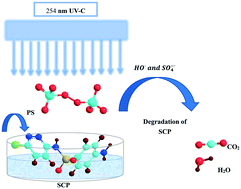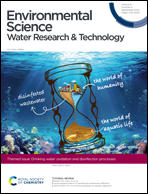Degradation of sulfachloropyridazine by UV-C/persulfate: kinetics, key factors, degradation pathway†
Abstract
Antibiotics are frequently detected in water, which can pose a great threat to human health. In this paper, an ultraviolet/persulfate (UV-C/PS) advanced oxidation process was utilized to remove a common antibiotic sulfachloropyridazine (SCP) efficiently from groundwater. The degradation mechanism and kinetics were investigated by researching several key influencing factors, including two radical scavengers (tert-butanol and methyl alcohol), dosages of PS, initial pH, anions (H2PO4−, HPO42−, Cl−, HCO3− and NO3−) and natural organic matter. The degradation of SCP followed a pseudo-first-order kinetic model and better degradation was achieved in acidic conditions than in alkaline conditions. The effect of scavengers indicated that both SO4−˙ and HO˙ contributed to the degradation of SCP and SO4−˙ played a major role. The degradation rate constants of SCP with SO4−˙ and HO˙ at the initial pH of 6.3 were calculated to be kSCP,HO˙ = 0.867 × 109 M−1 s−1 and kSCP,SO4−˙ = 3.073 × 109 M−1 s−1 in the UV-C/PS system by the relative rate method. Increasing the concentration of PS obviously facilitated the degradation and mineralization rates of SCP, which could reach 100% and 90%, respectively, at a PS dosage of 4.0 mM after 2 h. Also, H2PO4− and Cl− promoted the degradation of SCP, whereas the removal of SCP was restrained by the addition of HPO42−, HCO3− and large dosages of NO3−. The proposed degradation pathway of SCP was obtained by analyzing the intermediates.

- This article is part of the themed collection: Drinking water oxidation and disinfection processes


 Please wait while we load your content...
Please wait while we load your content...